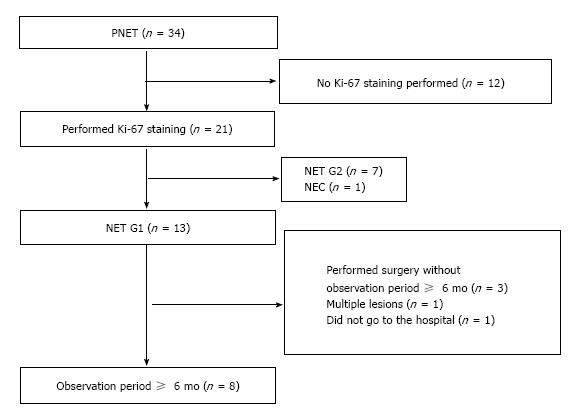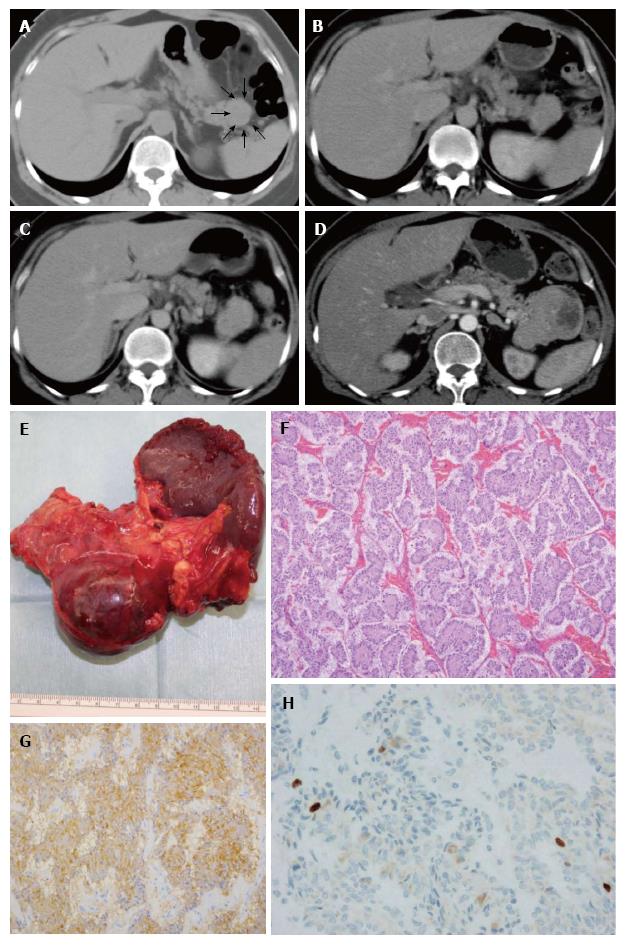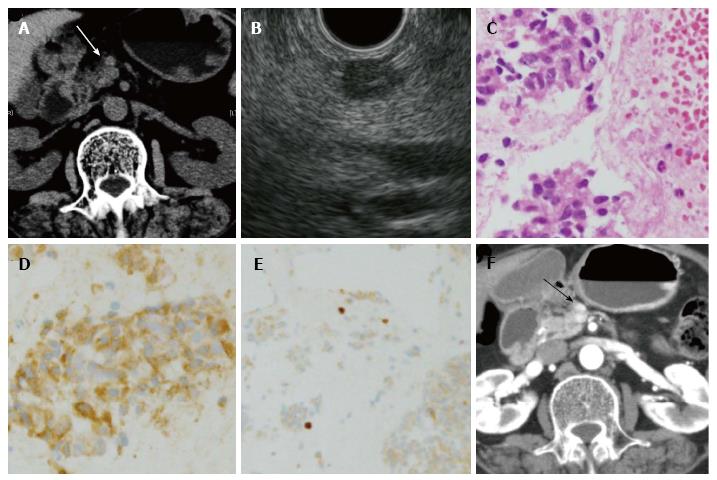Copyright
©The Author(s) 2017.
World J Clin Oncol. Jun 10, 2017; 8(3): 293-299
Published online Jun 10, 2017. doi: 10.5306/wjco.v8.i3.293
Published online Jun 10, 2017. doi: 10.5306/wjco.v8.i3.293
Figure 1 The characteristics of pancreatic neuroendocrine tumor patients at our hospital.
A total of 34 patients were diagnosed with PNETs. Among these patients, 21 had specimens that underwent Ki-67 immunostaining. There were 13 PNET G1 patients, and the observation period was more than six months long for eight PNET G1 patients. PNET: Pancreatic neuroendocrine tumor; G1: Grade 1.
Figure 2 The patient who exhibited growth of the pancreatic neuroendocrine tumor.
A: Abdominal CT. Initial CT indicated a PNET. The lesion was identified in the pancreatic tail. The diameter of the PNET was 34 mm (arrow); B: The lesion grew slightly after 11 mo; C: The lesion grew further after 29 mo; D: The diameter of the tumor became larger than 70 mm after 79 mo; E: The patient underwent distal pancreatectomy after 80 mo; F: Hematoxylin and eosin stain (× 100). Tumor cells formed ribbon-like lines; G: Chromogranin A staining (× 200). Tumor cells were chromogranin A positive; H: The Ki-67 index was 0.9%, with tumor grade G1 (× 200). PNET: Pancreatic neuroendocrine tumor; CT: Computed tomography.
Figure 3 Pancreatic neuroendocrine tumor case followed up without surgery.
A: Abdominal CT. A tumor was recognized in the pancreatic body. The diameter of the lesion was 8 mm; B: Endoscopic ultrasonography. The tumor was recognized as a low echoic lesion. A 22G needle was inserted into the tumor; C: Hematoxylin and eosin stain (× 400). Spindle-shaped tumor cells with ellipse nuclei formed funicular lines; D: Chromogranin A staining (× 400). Tumor cells were chromogranin A-positive; E: The Ki-67 index was < 1.0% (× 200), with tumor grade G1; F: Abdominal CT. The tumor did not grow after 54 mo. PNET: Pancreatic neuroendocrine tumor; CT: Computed tomography.
- Citation: Sugimoto M, Takagi T, Suzuki R, Konno N, Asama H, Watanabe K, Nakamura J, Kikuchi H, Waragai Y, Takasumi M, Kawana S, Hashimoto Y, Hikichi T, Ohira H. Pancreatic neuroendocrine tumor Grade 1 patients followed up without surgery: Case series. World J Clin Oncol 2017; 8(3): 293-299
- URL: https://www.wjgnet.com/2218-4333/full/v8/i3/293.htm
- DOI: https://dx.doi.org/10.5306/wjco.v8.i3.293











